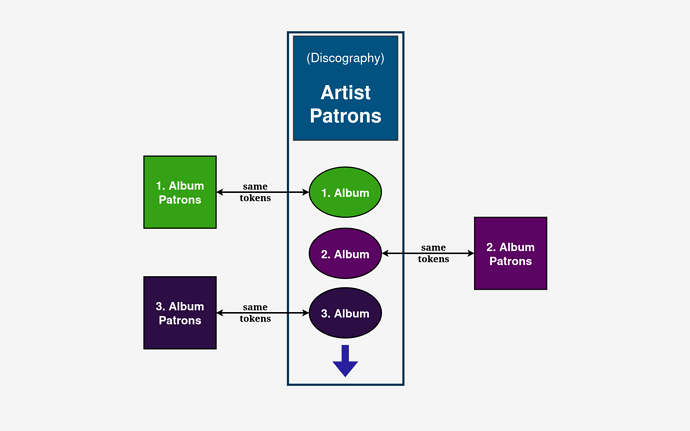I created [A] token-agnostic minimal interface, [B] IERC721, [C] Specific implementation for multi-collectional tokens.
Core idea is based on binding. If token is bound to collection: it become tradable there. If not: untradable.
Binding strategies depends on implementation. It could be:
mint-burn-mint
unlock-lock-unlock
transfer to owner - transfer to collection - transfer to owner.
In my working code: mint for current smaller collection; unlock for core. But smaller always can do something else (that core code allowed).
[A] IBindableToken: content-finance-contracts/src/token/common/bindable/IBindableToken.sol at master · sebasky-eth/content-finance-contracts · GitHub
It’s just face for dApps. Informs about potential binds for users. If token is bindable, dApps could list what kind of collections will come with specific token. Very important for exchanges.
[B] IERC721Bindable: content-finance-contracts/src/token/common/bindable/IBindableToken.sol at master · sebasky-eth/content-finance-contracts · GitHub
It’s also face, but extended for IERC721.
effectiveOwnerOf(uint256 tokenId) gives information about ownership in entire cross-collection.
isBound(uint256 tokenId) points to binding status for token
[C] Multipaired group: core collection has all tokens, smaller ones act like groups. Token can belong only to two collections: core or its specific group.
It’s highly utilized for gas:
- All collections are deployed by CREATE3 factory, so verification of binding mechanism is cheap. Core has salt 0. Smaller ones: bytes32(groupId).
- Core collection must has in tokenId information about group: [tokenIdInGroup][groupId].
- There a lot more to optimize, but not in my collection, because it was released before core. So it act independently from it. However, if core is released, smaller ones don’t need to store ownership data

Core: IERC721MultipairedBinder (content-finance-contracts/src/token/erc721/IERC721MultipairedBinder.sol at master · sebasky-eth/content-finance-contracts · GitHub)
Smaller: IERC721PairedBinder (content-finance-contracts/src/token/erc721/IERC721PairedBinder.sol at master · sebasky-eth/content-finance-contracts · GitHub)
For indexers:
IERC721PairedBinder (smaller) emit:
MultiGroupRegistered(IBindableMultiGroup indexed core, uint256 indexed groupIdInCore)
That to points to its core.
IERC721MultipairedBinder (bigger) emits:
BinderFactory(address factory)
For verification of PairedBinders.
GroupMetadata(uint256 offsetInGroupId, uint256 bitWidthInGroupId, uint256 offsetInTokenId, uint256 bitWidthInTokenId)
For fast mapping: tokenId in core ↔ tokenId in specific group
Deployed Implementation of smaller collection: ERC721PairedBinderPrelaunched
(content-finance-contracts/src/token/erc721/open-zeppelin-extensions/ERC721PairedBinderPrelaunched.sol at master · sebasky-eth/content-finance-contracts · GitHub)
For IERC165 interface I went to: IBindableToken, IERC721Bindable, IERC721PairedBinder
However IERC721Bindable was overkill. I think IBindableToken, IERC721PairedBinder was enough.
Binding works by:
Owner call bind → contract call unbindFor in other (limitation is to one maximum bind).
Owner call unbind → contract call bindFor in other.
Owner send token to collection → contract call unbindFor, bindFor depending on to.
How prerelease work?
Unbinding is blocked from core until it was done at last once.
Every transfer call low-level call IERC721MultipairedBinder.mirroredTransferFrom.
There are also more possible systems
SoloBinders: IDirectedBinder (content-finance-contracts/src/token/common/bindable/IDirectedBinder.sol at master · sebasky-eth/content-finance-contracts · GitHub)
Does not need core. Owner select new target for binding in active binder. Or call target collection with previous binder.
You could use IERC721CoreBinder (content-finance-contracts/src/token/erc721/IERC721CoreBinder.sol at master · sebasky-eth/content-finance-contracts · GitHub) for custom centralized system. IERC721MultipairedBinder, which I focus on, has strong limitations: 2 collections max for specific token.
